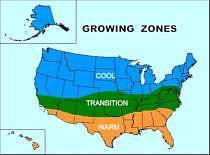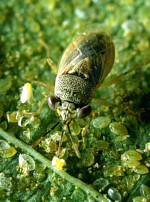Chinch bugs are native to the United States and can be found in lawns and gardens throughout. Part of the insect order Hemiptera known as “True Bugs”, they have piercing-sucking mouth-parts used to feed on the sap of grass plants. These lawn insect pests will do significant damage when populations are high and the weather is hot and dry.
There are two primary species that cause damage to lawns and golf courses. The hairy chinch bug feeds on cool-season turfgrasses and the southern chinch bug is a major pest of St. Augustine grass but it will also feed on other warm-season grasses. The appearance, damage that they cause and life cycle of these two species are very similar.

The adults are tiny – only 5 mm long. They are colored black with white wings that fold flat on their back, brown legs and brown antennae. Each wing has a distinctive, black triangular mark. There are short and long-winged varieties and both can be present at the same time.

Newly hatched nymphs are reddish with a pale white band across their abdomen. They gradually change colors as they molt through five growth stages. They develop wings and can fly when they reach the adult stage.
Life Cycle
Weather is the primary factor governing chinch activity and population sizes. There are usually 2 generations – sometimes 3 – each summer of the hairy chinch bug. The Southern chinch can have between 5 and 7 generations per year. Populations are the highest in mid-summer – when temperatures are above 90 F ° – and all life stages will be present.
Adults overwinter in heavy grass thatch or other garden debris in flower and landscape beds and emerge with warm spring weather. The adults begin mating when the temperatures warm to 70 ° F. Each female lays several hundred eggs at a rate of 15 to 20 per day. She deposits them in the soil around roots, behind the lower leaf sheaths and around crowns of grass plants – laying them in the driest area she can find.
The wingless nymphs hatch in one to three weeks and begin feeding. They develop through five molts (instars) for about 30 days before they reach the winged adult stage. The complete life cycle takes about 6 weeks depending on temperature. The new adults lay eggs from July through August. The second generation completes its development in the fall and they overwinter as adults.
Damage Caused by These Bugs
Most damage is caused to lawns that are water-stressed – while chinch bugs thrive in hot, dry weather.
They will cause severe damage when numbers are high – densities can reach 200 bugs per ft2. Bug populations are influenced by the weather – Hot, dry weather encourages chinch infestation while wet periods, extreme cold spells and humid weather will suppress populations.
Chinch bugs use their piercing-sucking mouth parts to suck the sap from the stems and crowns of grass plants weakening the plants and causing death. They will also inject a toxin while feeding that causes plant decline. You will find them feeding in groups with the nymphs doing the most damage.
Lawn injury usually appears in mid-summer – it is not as noticeable in the spring and fall. These bugs are so tiny the damage can go unnoticed until it is too late. The damage shows up as irregular dead patches with yellowed borders and is often confused with drought stress or fungal disease. The patches enlarge as the population increases and spreads.
Controlling Chinch Bugs
Most of the time, chemical control is not necessary. Lawns that are watered properly throughout the summer will be able to tolerate high chinch populations without showing damage. Healthy lawns will also have natural populations of insect predators that will keep chinch numbers in check.
Monitoring Populations
The first step to controlling chinch bugs is to be certain they are causing the damage. Look in areas with a thick thatch layer, in full sun and showing signs of drought stress. On hot days they can be found on driveways and sidewalks bordering infested turf.
Inspect irregular patches of dead grass with yellowed borders. Check for the bugs along the outer edges of the dead patches – they can be found on the soil surface and at the crown of grass plants.
The easiest way to scout for these tiny bugs is to cut the bottom from a coffee can, and insert the can several inches into the ground where the yellowed border meets green grass – this is where they will be actively feeding. Fill the can with water – let it soak in – and fill it again. In approximately 10 minutes the bugs will float to the top.
You can consider spraying if you find several in the can – don’t spray if you trap only one or two.
Cultural Control
There are several ways to make your lawn less attractive to chinch bugs.
A good place to start is by following a good lawn maintenance plan – including proper mowing, watering, and fertilizing. Remove excess thatch – an ideal setting for chinch survival – by core aerating or mechanical dethatching. Keeping your lawn healthy will make it resistant to insect attacks.
Consider using insect-resistant varieties of St. Augustine and use endophyte-enhanced cool-season grasses. ‘Floratam’ and ‘Floralawn’ are St. Augustine grass cultivars that are resistant to chinch bugs. Endophyte-enhanced cool-season grasses have shown a high resistance to foliar-feeding insects.
Biological Control
Chinch bugs are attacked by a variety of predators – insect predators, birds and the parasitic fungus Beauveria bassiana.

Big-eyed bugs are the main insect predators of chinch. Lady bugs, lacewings, ants, ground beetles and parasitic wasps will also feed on chinch.
Beauveria bassiana is a naturally occurring parasitic fungus that is present where chinch bug populations are high. Hot, humid weather and a moist environment promote the growth of this fungus. It will naturally keep chinch populations in check. Watering your lawn when it is hot and dry will help this fungus parasitize the bugs.
Promoting natural enemies that eat or kill insect pests is a much more sustainable and long-term approach to pest control than chemical control.
Chemical Control
Once you have determined populations are high enough to justify chemical control, insecticides – used according to the label – can rapidly reduce insect numbers and prevent significant damage.
You do not need to treat your whole lawn. Spot treat infected areas – where the bugs are actively feeding.
Always read and follow the label when handling and applying pesticides.
There are several products labeled for chinch bug control including:
- Orthene®
- Spectracide® Liquid Insecticide Spray
- Bayer Advanced Complete Insect Killer
- Sevin®
You might like these lawn care tips:
How To Compost Grass Clippings
Are you having trouble managing a stinky, slimy heap of grass clippings? Here’s how to compost grass clippings without the smelly mess. Simple composting tips.
Spring Lawn Care & Maintenance Tips
10 Spring Lawn Care maintenance tips. How to care for a lawn in spring and prepare it for the summer season.DIY tips and advice for planting and growing grass.
Lawn Striping | Mowing Patterns | Lawn Mower Striping Kits
How to cut grass like a pro. Lawn striping is a simple mowing technique that uses lawn rollers or striping kits for a professionally groomed look. Pattern your yard like a baseball field.

